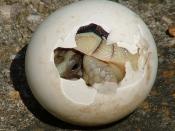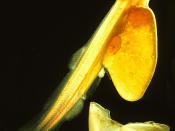Reptiles are often thought of as slimy, but their skin their skin is actually cool, dry, and leathery. The scales, which give the reptiles' skin their texture, are part of a thick skin with few glands. The reptile must periodically shed its outgrown scales and replace then with a larger set, which the reptile grows before it sheds the old. Their thick skin helps them conserve some heat in its body. Many sun themselves to warm their bodies, but too much heat can kill them. So in hot weather, they hide in cool places and in cold weather they hide and enter and inactive state similar to hibernation.
Reptiles produce amniotic eggs which maintain a suitably moist environment for the developing animal. These eggs must be fertilized within the female. Once fertilized, the egg is encased in a protective shell and is passed from the female's body. The shell is porous, permitting the exchange of gases between the egg and the environment, but preventing excess water loss.
Four embryonic membranes form during development within the egg. The first membrane is the amnion and grows around the embryo, protecting it in a fluid-filled sac. The second membrane is the yolk sac, which surrounds the yolk. The third membrane is the chorion, which lines the inner surface of the shell. The fourth membrane, the allantois, is a sac richly supplied with blood vessels from the embryo.
The circulatory system is more highly developed than that of amphibians. Most reptiles have a three-chambered heart with a partial wall inside the main chamber. This means that less mixing of oxygen-filled blood and carbon dioxide-filled blood occurs than in amphibians. This type of circulatory system provides more oxygen to all the parts of the body.
Reptiles are important predators in many environments. In farming...


